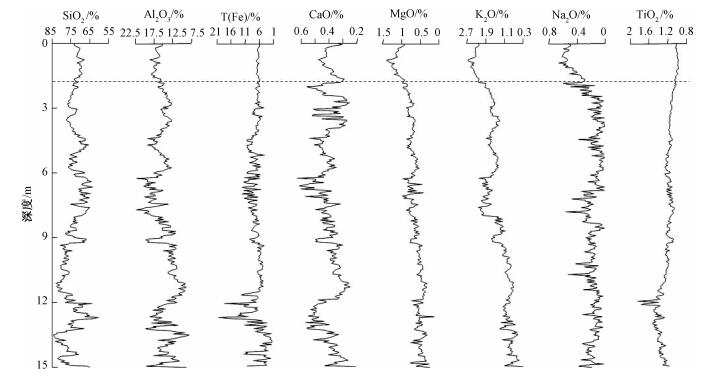| [1] |
陈治荣, 何银武.据14C年龄数据浅议广汉粘土与成都粘土的时代归属[J].山地学报, 1990, 8(3):167~173.CHEN Zhi-rong, HE Yingwu. A preliminary discussion on date determination of Guanghan Clay and Chengdu Clay with 14C[J]. Journal of Mountain Science, 1990, 8(3):167~173.
|
| [2] |
Yang Shengli, Fang Xiaomin, Shi Zhengtao, et al. Timing and provenance of loess in the Sichuan Basin at the eastern margin of the Tibetan Plateau, southwestern China[J]. Palaeogeography, Palaeoclimatology, Palaeoecology, 2010, 292(1-2):144~154. doi: 10.1016/j.palaeo.2010.03.039
|
| [3] |
赵志中, 乔彦松, 王燕, 等.成都平原红土堆积的磁性地层学及古环境记录[J].中国科学:D辑, 2007, 37(3):370~377. http://www.cnki.com.cn/Article/CJFDTOTAL-JDXK200703009.htmZHAO Zhi-zhong, QIAO Yan-song, WANG Yan, et al. The magnetic stratigraphy and the palaeoenvironmental record of red clay in Chengdu plain[J]. Science in China:Series D, 2007, 37(3):370~377. http://www.cnki.com.cn/Article/CJFDTOTAL-JDXK200703009.htm
|
| [4] |
Thorp J, Dye D S. The Chengdu clays deposits of possible aeolian origin in western and northwestern Sichuan Basin[J]. Bulletin of the Geological Society of China, 1936, 15(2):225~246.
|
| [5] |
汪波, 聂前勇, 王运生, 等.也论成都粘土的成因[J].地质灾害与环境保护, 2002, 13(1):54~64. http://www.cnki.com.cn/Article/CJFDTOTAL-DZHB200201014.htmWANG Bo, NIE Qian-yong, WANG Yun-sheng, et al. Discussion on the genetic mechanism of Chengdu clay[J]. Journal of Geological Hazards and Environment Preservation, 2002, 13(1):54~64. http://www.cnki.com.cn/Article/CJFDTOTAL-DZHB200201014.htm
|
| [6] |
乔彦松, 赵志忠, 李增悦, 等.成都平原红土堆积的风成成因证据[J].第四纪研究, 2007, 27(2):286~291. http://www.cnki.com.cn/Article/CJFDTOTAL-DSJJ200702014.htmQIAO Yan-song, ZHAO Zhi-zhong, LI Zeng-yue, et al. Aeolian origin of the red earth formation in the Chengdu plain[J]. Quaternary Sciences, 2007, 27(2):286~291. http://www.cnki.com.cn/Article/CJFDTOTAL-DSJJ200702014.htm
|
| [7] |
胡兆国, 冯金良, 鞠建廷.成都粘土中石英的粒度分布及其表面微结构特征[J].山地学报, 2010, 28(4):392~406. http://www.cnki.com.cn/Article/CJFDTOTAL-SDYA201004002.htmHU Zhao-guo, FENG Jin-liang, JU Jian-ting. Grain size distribution and microstructure of quartz in the Chengdu Clay[J]. Journal of Mountain Science, 2010, 28(4):392~406. http://www.cnki.com.cn/Article/CJFDTOTAL-SDYA201004002.htm
|
| [8] |
邵之刚, 李代钧, 李永昭. 成都平原更新世粘土的地质特征[C]//中国地质学会第四纪冰川与第四纪地质专业委员会, 江苏省地质学会. 第四纪冰川与第四纪地质论文集(一). 北京: 地质出版社, 1984: 142~152.SHAO Zhi-gang, LI Dai-jun, LI Yong-zhao. Geological characteristics of Pleistocene clay in the Chengdu Plain[C]//Commission on Quaternary Glaciology and Geology of the Geological Society of China, Geological Society of Jiangsu Province. Contribution to the Quaternary glaciology and Quaternary geology (1). Beijing:Geological Publishing House, 1984:142~152.
|
| [9] |
Feng Jinliang, Hu Zhaoguo, Ju Jianting, et al. Variations in trace element (including rare earth element) concentrations with grain sizes in loess and their implications for tracing the provenance of eolian deposits[J]. Quaternary International, 2011, 236(1-2):116~126. doi: 10.1016/j.quaint.2010.04.024
|
| [10] |
Yang Shengli, Fang Xiaomin, Yan Maodu, et al. Grain size profiles in the Chengdu Clay, eastern margin of the Tibetan Plateau:Implications for significant drying of Asia since~500 ka B P[J]. Journal of Asian Earth Sciences, 2010, 38(1-2):57~64. doi: 10.1016/j.jseaes.2009.12.005
|
| [11] |
刘东生.黄土与环境[M].北京:科学出版社, 1985:238~255.LIU Dong-sheng. Loess and the environment[M]. Beijing:Science Press, 1985:238~255.
|
| [12] |
文启忠.中国黄土地球化学[M].北京:科学出版社, 1989:23~63.WEN Qi-zhong. Geochemistry of Chinese loess[M]. Beijing:China Science Press, 1989:23~63.
|
| [13] |
Gallet S, Jahn B M, Torii M. Geochemical characterization of the Luochuan loesse-paleosol sequence, China, and paleoclimatic implications[J]. Chemical Geology, 1996, 133(1-4):67~88. doi: 10.1016/S0009-2541(96)00070-8
|
| [14] |
陈骏, 季峻峰, 仇纲, 等.陕西洛川黄土化学风化程度的地球化学研究[J].中国科学:D辑, 1997, 27(6):531~536. http://www.cnki.com.cn/Article/CJFDTOTAL-JDXK199706009.htmCHEN Jun, JI Jun-feng, QIU Gang, et al. Study on geochemistry of loess chemical weathering extent in Luochuan profile, Shannxi Province[J]. Science in China:series D, 1997, 27(6):531~536. http://www.cnki.com.cn/Article/CJFDTOTAL-JDXK199706009.htm
|
| [15] |
Xiong Shangfa, Ding Zhongli, ZhuYuanjian, et al. A~6 Ma chemical weathering history, the grain size dependence of chemical weathering intensity, and its implications for provenance change of the Chinese loess-redclay deposit[J]. Quaternary Science Reviews, 2010, 29(15-16):1911~1922. doi: 10.1016/j.quascirev.2010.04.009
|
| [16] |
乔彦松, 赵志中, 王燕, 等.川西甘孜黄土磁性地层学研究及其古气候意义[J].第四纪研究, 2006, 26(2):250~256. http://www.cnki.com.cn/Article/CJFDTOTAL-DSJJ200602012.htmQIAO Yan-song, ZHAO Zhi-zhong, WANG Yan, et al. Magnetostratigraphy and its paleoclimatic significance of a loess-soil sequence from Ganzi area, west Sichuan plateau[J]. Quaternary Sciences, 2006, 26(2):250~256. http://www.cnki.com.cn/Article/CJFDTOTAL-DSJJ200602012.htm
|
| [17] |
乔彦松, 赵志中, 王燕, 等.川西甘孜黄土-古土壤序列的地球化学演化特征及其古气候意义[J].科学通报, 2010, 55(3):255~260. http://www.cnki.com.cn/Article/CJFDTOTAL-KXTB201003008.htmQIAO Yan-song, ZHAO Zhi-zhong, WANG Yan, et al. Variations of geochemical compositions and the paleoclimatic significance of a loess-soil sequence from Garzê County of western Sichuan Province, China[J]. Chinese Science Bulletin, 2009, 54(24):4697~4703. http://www.cnki.com.cn/Article/CJFDTOTAL-KXTB201003008.htm
|
| [18] |
Nesbitt H W, Markovices G, Price R C. Chemical processes affecting alkalis and alkaline earths during continental weathering[J]. Geochimica et Cosmochimica Acta, 1980, 44:1659~1666. doi: 10.1016/0016-7037(80)90218-5
|
| [19] |
冯增昭.沉积岩石学[M].北京:石油工业出版社, 1993:16~20.FENG Zeng-zhao. Sedimentary petrology[M]. Beijing:Petroleum Industry Press, 1993:16~20.
|
| [20] |
Nesbitt H W, Young G M. Early Proterozoic climates and plate motions inferred from major element chemistry of lutites[J]. Nature, 1982, 299:715~717. doi: 10.1038/299715a0
|
| [21] |
冯连君, 储雪蕾, 张启锐, 等.化学蚀变指数(CIA)及其在新元古代碎屑岩中的应用[J].地学前缘, 2003, 10(4):539~544. http://www.cnki.com.cn/Article/CJFDTOTAL-DXQY200304027.htmFENG Lian-jun, CHU Xue-lei, ZHANG Qi-rui, et al. CIA (Chemical Index of Alteration) and its applications in the Neoproterozoic clastic rocks[J]. Earth Science Frontiers, 2003, 10(4):539~544. http://www.cnki.com.cn/Article/CJFDTOTAL-DXQY200304027.htm
|
| [22] |
陈骏, 安芷生, 刘连文, 等.最近2.5 Ma以来黄土高原风尘化学组成的变化与亚洲内陆的化学风化[J].中国科学:D辑, 2001, 31(2):136~145. http://www.cnki.com.cn/Article/CJFDTOTAL-JDXK200102006.htmCHEN Jun, AN Zhi-sheng, LIU Lian-wen, et al. Variations in chemical compositions of the eolian dust in Chinese Loess Plateau over the past 2.5Ma and chemical weathering in the Asian inland[J]. Science in China:Series D, 2001, 31(2):136~145. http://www.cnki.com.cn/Article/CJFDTOTAL-JDXK200102006.htm
|
| [23] |
顾兆炎, 丁仲礼, 熊尚发, 等.灵台红粘土和黄土-古土壤序列的地球化学演化[J].第四纪研究, 1999, (4):357~365. http://www.cnki.com.cn/Article/CJFDTOTAL-DSJJ199904007.htmGU Zhao-yan, DING Zhong-li, XIONG Shang-fa, et al. A seven million geochemical record from Chinese red-clay and loess-paleosol sequence:Weathering and erosion in northwestern China[J]. Quatanary Sciences, 1999, (4):357~365. http://www.cnki.com.cn/Article/CJFDTOTAL-DSJJ199904007.htm
|
| [24] |
孙福庆, 文启中, 刁桂仪, 等.古土壤地球化学的某些问题——黄土风化过程中元素的变化[J].土壤学报, 1983, 20(2):101~111. http://www.cnki.com.cn/Article/CJFDTOTAL-TRXB198302000.htmSUN Fu-qing, WEN Qi-zhong, DIAO Gui-yi, et al. On the geochemical characteristics of paleosol the change of chemical elements in loess during weathering process[J]. Acta Pedologica Sinica, 1983, 20(2):101~111. http://www.cnki.com.cn/Article/CJFDTOTAL-TRXB198302000.htm
|
| [25] |
张虎才, 张林源, Mahaney W C.兰州九州台黄土剖面元素地球化学研究[J].地球化学, 1991, 20(1):79~84. http://www.cnki.com.cn/Article/CJFDTOTAL-DQHX199101009.htmZHANG Hu-cai, ZHANG Lin-yuan, Mahaney W C. Element geochemistry of the Jiuzhoutai loess section, Lanzhou[J]. Geochimica, 1991, 20(1):79~84. http://www.cnki.com.cn/Article/CJFDTOTAL-DQHX199101009.htm
|
| [26] |
靳鹤龄, 苏志珠, 孙忠.浑善达克沙地全新世中晚期地层化学元素特征及其气候变化[J].中国沙漠, 2003, 23(4):366~372. http://www.cnki.com.cn/Article/CJFDTOTAL-ZGSS200304005.htmJIN He-ling, SU Zhi-zhu, SUN Zhong. Characters of chemical elements in strata of middle and late Holocene in Hunshandake Desert and the indicating climatic changes[J]. Journal of Desert Research, 2003, 23(4):366~372. http://www.cnki.com.cn/Article/CJFDTOTAL-ZGSS200304005.htm
|
| [27] |
Nesbitt H W, Young G M. Prediction of some weathering trends of plutonic and volcanic rocks based on thermodynamic and kinetic considerations[J]. Geochimica et Cosmochimica Acta, 1984, 48(7):1523~1534. doi: 10.1016/0016-7037(84)90408-3
|





 下载:
下载:







